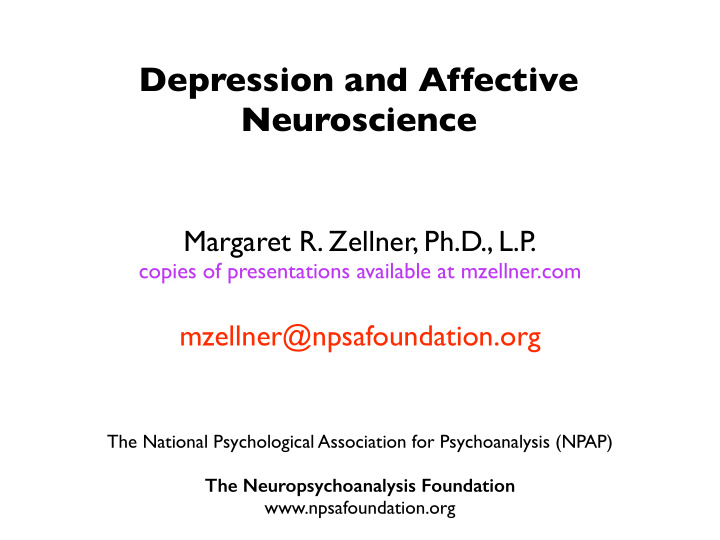



Depression and Affective Neuroscience Margaret R. Zellner, Ph.D., L.P . copies of presentations available at mzellner.com mzellner@npsafoundation.org The National Psychological Association for Psychoanalysis (NPAP) The Neuropsychoanalysis Foundation www.npsafoundation.org
genetic vulnerability intrapsychic factors SES early life stress loss depression psychotherapy brain stimulation medication social support exercise nutrition
action perception emotion
motivation PAG activation of emotion generation of emotion adapted from Berton and Nestler 2006 Nat Rev Neurosci
FRONTAL PARIETAL planning the body and objects in - WHAT and HOW to do space - WHERE things are TEMPORAL recognition of objects and people - WHO things are VMPFC, ANTERIOR TEMPORAL memory, emotion, reward - meaning, or, WHY to do or Marcel Mesulam, 2000 Principles of Behaviora and not to do Cognitive Neurology
Guevara et al 2012, NeuroImage
van den Heuvel & Sporns 2011 J Neurosci
and of course it’s all connected... Kelley et al 2005 Kelley et al 2005
“resting state” networks Somatomotor Dorsal areas presumed to be connected attention continuously active dynamically interactive Frontoparietal correspond to functional studies Default Salience Visual Default Dorsal S o m a Frontoparietal Limbic t o attention m o t o r Salience Default Default Visual Limbic Yeo et al 2011 J Neurophysiol
default mode network mind-wandering daydreaming stimulus-independent thought simulation episodic/autobiographical memory Buckner et al 2008
DMN correlated with spontaneous cognition Andrews-Hanna et al 2010 J Neurophysiology
attention network switching attention executive control/ frontoparietal network working memory staying on task maintaining focus salience network encoding “value” monitoring errors subjective experience (“aha” moments, craving, and more)
salience working memory (fronto- sensory, auditory, motor parietal and dorsal attention) DMN visual Doucet et al 2011 J Neurophysio
Uddin 2015 NATURE REVIEWS | NEUROSCIENCE Craig 2009 NATURE REVIEWS | NEUROSCIENCE
Uddin 2015 NATURE REVIEWS | NEUROSCIENCE Eisenberger 2012 Nat Rev Neurosci
Salience network implicated across many psychiatric disorders gray matter loss across 6 diagnoses (schizophrenia, bipolar disorder, depression, addiction, obsessive-compulsive disorder, and anxiety) - the dorsal anterior cingulate, right insula, left insula Goodkind et al 2015 JAMA Psychiatry
Emotion, instinct, drive Attention, perception, regulation Panksepp and Solms 2012 Trends Cog Sci
Panksepp 2006 Prog Neuro-Psychopharm and Bio Psych
SEEKING ( â PLAY) ( á RAGE) RAGE â PLAY á FEAR FEAR â PLAY, LUST, SEEKING á RAGE LUST CARE â GRIEF PANIC/GRIEF â PLAY áâ SEEKING á FEAR PLAY ACC fundamentally dynamic system NAcc L VTA M M BNST Hyp POA POA POA/ D D M M L Amy PAG C/L
PANIC/GRIEF System Panksepp 2003
PANIC/GRIEF System SEEKING System Coenen et al 2012 J Neuropsychiatry Clin Neurosci
PANIC/GRIEF System SEEKING System Coenen et al 2012 J Neuropsychiatry Clin Neurosci
Affect Regulation Arnsten and Rubia J Am Acad Child Adolesc Psychiatry 2012
Kupfer, D. J., Frank, E., & Phillips, M. L. (2012). Major depressive disorder: new clinical, neurobiological, and treatment perspectives. Lancet , 379 (9820), 1045–1055. doi:10.1016/S0140-6736(11)60602-8
Disner, S. G., Beevers, C. G., Haigh, E. A. P., & Beck, A. T. (2011). Neural mechanisms of the cognitive model of depression. Nature Reviews Neuroscience , 12 (8), 467–477. doi:10.1038/nrn3027
Disner, S. G., Beevers, C. G., Haigh, E. A. P., & Beck, A. T. (2011). Neural mechanisms of the cognitive model of depression. Nature Reviews Neuroscience , 12 (8), 467–477. doi:10.1038/nrn3027
PANIC-shutdown model of depression (Panksepp & Watt 2009) euthymia • baseline opioid and oxytocin tone (social contact, good internal objects) • responsive DA system • appropriate levels of other global neuromodulators (NE, ACh, 5-HT) or depressive • impaired infrastructure due to history • impaired infrastructure due to genes • depressive intrapsychic factors: vulnerability intrapsychic conflict/defenses around grieving (“the shadow of the object”/ relating to negative internal objects) loss: á HPA activation á DA release, NE, ACh Bowlby: protest separation distress â opioids á dynorphin termination of separation distress: shut down reunion sadness } Berton and Nestler, 2006 CREB and Dynorphin in NAC in Depression: á opioids, oxytocin â opioids, oxytocin despair + â HPA activation â HPA activation á DA tone â DA tone depression á PNS activation • circadian disruption • immune system - “sickness behavior” • continued dynorphin activation? decathexis • chronic HPA activation, leading to cognitive and immune problems, hypersensitive amygdala, other…
Questions and discussion?
Additional slides
basic emotion systems “protoself” hypothalamus SC PBN NTS Antonio Damasio Jaak Panksepp Self Comes to Mind (2012) Affective Neuroscience ( 1998) Archeology of Mind (2012)
Neural interactions characteristics of brain emotional systems: Various sensory stimuli can unconditionally access emotional systems; 1) Emotional systems generate instinctual motor outputs & 2) Modulate sensory inputs. 3) Emotional systems have positive feedback components which can sustain 4) emotional arousal after precipitating events have passed. These systems can be modulated by cognitive inputs, & 5) These systems can modify/channel cognitive activities. 6) Panksepp 2011 PLoS One
Recommend
More recommend